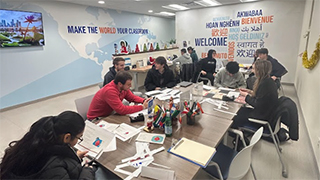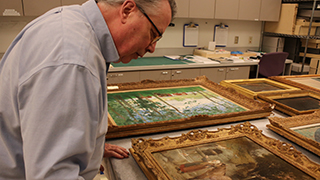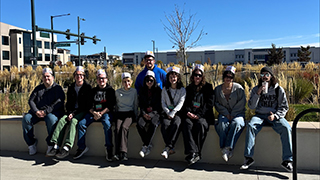Seton Hall's Chemistry Program Goes Green - Seton Hall University
Tuesday, March 12, 2019
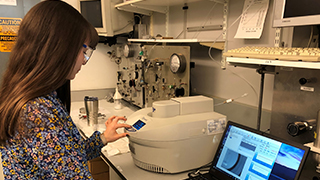
These efforts are largely a response to the detrimental effects of toxic waste, rising energy prices, scarcity of natural resources and rising levels of carbon dioxide and pollutants in our atmosphere. But what if there were a way to be more proactive – to use less energy and/or prevent waste products altogether?
This is where the College of Arts and Sciences has come into play, with its increased focus on an initiative known as "green chemistry." Put simply, green chemistry is the practice of making chemical processes more efficient so that everything that goes into a chemical reaction emerges at the other end of that reaction with no unwanted by-products and, therefore, less waste. It is built upon a foundation of 12 principles, including catalysis, atom economy, the development of safer chemicals, and the use of renewable feedstocks.
"While the term 'green chemistry' is relatively new, the fundamental principles have been around forever. It's just that, historically, they weren't treated as a high priority in teaching laboratories and lecture halls," says Assistant Professor David Laviska, Ph.D. "But they are being taken much more seriously within academia since 'going green' has become more of a global priority. There are journals and conferences that focus on these principles now, and the number of scientists who incorporate them into their research and teaching initiatives is growing rapidly."
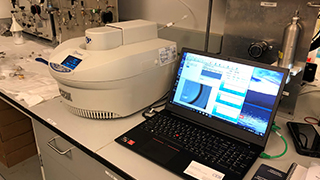
A microwave reactor has been installed in Seton Hall's chemistry labs by CEM Corporation, for student and faculty research.
Laviska is heavily involved in the initiative to infuse green chemistry practices into Seton Hall's teaching and research labs, alongside Professors Wyatt Murphy, Ph.D. and Cecilia Marzabadi, Ph.D.; Professor Emeritus Robert Augustine, Ph.D.; and Setrak Tanielyan, Ph.D., technical director of Seton Hall's newly renamed Center for Applied Catalysis and Green Chemistry, which has itself been incorporating green chemistry practices for more than two decades.
Though there are other institutions with faculty, administrators and courses dedicated to the practice of green chemistry, at Seton Hall, the entire Department of Chemistry and Biochemistry has committed to a complete overhaul of every laboratory experiment that's taught – providing students with a new set of skills and a new philosophy that will make them even more desirable to industrial employers as this movement continues to gain momentum.
"At many colleges and universities, a department-wide commitment to this kind of initiative wouldn't be possible. At smaller institutions where the faculty often have a good sense of community, they may lack the funding, the space, the infrastructure, etc., to do what we're initiating here. Larger institutions that would have those resources in abundance are often focused on the research and funding initiatives of individual faculty, so getting an entire department's collaborative support would likely be difficult," says Laviska. "Seton Hall is amazingly well positioned to succeed with something like this."
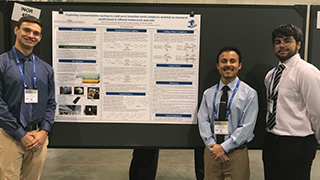
Sophomores Kyle Otto, Anthony Rodriguez, and Dominick Gamarro present their research to the American Chemical Society.
As of this semester, undergraduate students can now put green chemistry practices into action in their organic chemistry classes, with additional classes to follow within the next few years. But sophomore science majors Dominick Gamarro, Kyle Otto, and Anthony Rodriguez got a head start when they spent last summer pilot testing 10 different "greener" experiments – one of which is directly related to Laviska's own scholarly research initiative. Their work ultimately facilitated the initiation of green chemistry into the curriculum, as the piloted labs have been incorporated into the organic chemistry II laboratory course this semester, with additional experiments to follow during the summer session. The students then had the opportunity to present their work at the annual American Chemical Society (ACS) National Meeting and Exposition, which took place in Boston in August 2018.
"What I learned this summer was basically a whole year's worth of study," says Gamarro. "Even just attending the ACS Meeting, you learn more in those three days than you ever thought you would. I know how to better read between the lines, why things work the way they do, how to think more critically. The entire summer was really the best experience."
The green chemistry initiative at Seton Hall has also caught the attention of graduate students. Allyson Dixon, a first-year Ph.D. student in the Department of Chemistry and Biochemistry, had done her undergraduate capstone project on the 12 principles of green chemistry and was looking for a doctoral program that would allow her to continue pursuing her interest in this area. Dixon commented on her first exploratory visit to Seton Hall: "I met with Dr. Murphy and in our conversation, he mentioned all the work he was doing with regard to green chemistry. At that point, I knew this was where I wanted to get my Ph.D., and that I wanted to do my research under him".
The initiative is also showing early potential for external partnership opportunities. CEM Corporation, a leading provider of microwave instrumentation for analytical and synthetic chemistry applications, recently installed a microwave reactor in one of the University's chemistry labs as the result of a partnership that came about because of this initiative. In addition, talks are underway concerning the potential for a future collaborative student internship at IFF, Inc.
Green chemistry appears to have the potential to make the world a safer, healthier place for generations to come – and Seton Hall is in a prime position to be right at the forefront of it all.


